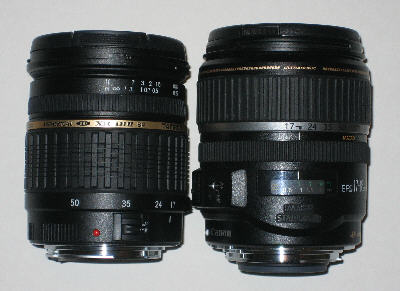
|
Tamron SP AF17-50mm F/2.8 XR Di-II LD Aspherical [IF] Review![Tamron SP AF17-50mm F/2.8 XR Di-II LD ASPHERICAL [IF]](tamron_17-50/a16.jpg)
The initial impression of the Tamron SP AF17-50mm F/2.8 XR Di-II LD Aspherical [IF] is that it's a solid lens. It feels "dense". Not heavy, but it gives the impression of solidity. The body seems to be made of a composite (plastic) material and the finish is in low-reflectivity black with a gold ring. Both the zoom and manual focus rings are covered in rubber with ribbing to make them easier to grip. The MF/AF switch is located near the lens mount and there is a "lock" button which can be used to lock the zoom at the 17mm position. The Tamron SP AF17-50mm F/2.8 XR Di-II LD Aspherical [IF] uses High Refractive Index glass (XR) to lower aberrations and make the lens more compact, Low Dispersion glass (LD) to minimize chromatic aberration and two Hybrid Aspherical Elements to further reduce residual aberrations and reduce the physical length of the lens. The zoom action is positive and smooth and the lens shows no sign of "zoom creep" (zoom setting does not change when the lens is pointed straight up or straight down). Canon users will notice that the zoom is "backwards" compared to Canon lenses, i.e. focal length increases when the zoom ring is turned to the right (clockwise from the rear). On Canon lenses focal length decreases when the zoom ring is turned to the right. The zoom can be locked at 17mm (presumably so that the lens can be locked at it's minimum length for carrying), though as I said, there isn't really any zoom creep under normal conditions anyway. Focus is also "backwards" for Canon users, close focus is obtained with the focus ring turned all the way to the left (anti-clockwise looking from the rear), whereas with Canon lenses close focus is obtained with the focus ring turned all the way to the right. The length of the lens increases by about 1.1" (28mm) at the 50mm setting compared to the 17mm setting. Focusing is internal, so the lens does not change length when focused. The front element does not rotate during focusing or zooming, but the manual focus ring does rotate during autofocus. I could feel no side-to-side or up-and-down play in the barrel when extended. The zoom is marked at focal lengths of 17mm, 24mm, 35mm and 50mm. The zoom range covers the same field of view as a 27-80mm zoom would on a full frame camera, so applications of this lens range from landscapes and interiors, to travel and portraits. Close focus is 27cm (10.6") at all focal lengths giving a magnification of 0.22x at the 50mm setting. A bayonet fitting "petal" style hood is supplied with the lens. The Tamron SP AF17-50mm F/2.8 XR Di-II LD Aspherical [IF] also comes with the standard Tamron 6 year warranty
AutofocusThe Tamron SP AF17-50mm F/2.8 XR Di-II LD Aspherical [IF] uses a conventional focus motor, so focus isn't silent like it is with Canon's lenses using USM motors. However the noise level is still pretty low and I can't imagine it being a problem for 99.9% of users (DSLRs make noise due to mirror and shutter movement anyway, so you can't shoot in absolute silence). When mounted on an EOS 20D DSLR, the time taken to shift from 0.27m to infinity (or infinity to 0.27m) averaged 0.40 seconds. The time to cycle from infinity to 0.27m and back to infinity (i.e. the widest focus search range) was 1.44s, the lens pausing for 0.644 at the close focus setting before returning to infinity. In comparison, the EF 17-85IS USM takes about 0.315s to go from infinity to 0.35m and the full cycle (infinity - 0.35m - infinity) takes 1 second. Here's an audio clip of the lens cycling from infinity to close focus and back to infinity. Audio Clip (32K .mp3 file). NEXT -> Part II - Distortion and Vignetting
© Copyright Bob Atkins All Rights Reserved |
|||||||||||||||||||||||||||||||||||
|
|
||||||||||||||||||||||||||||||||||||
